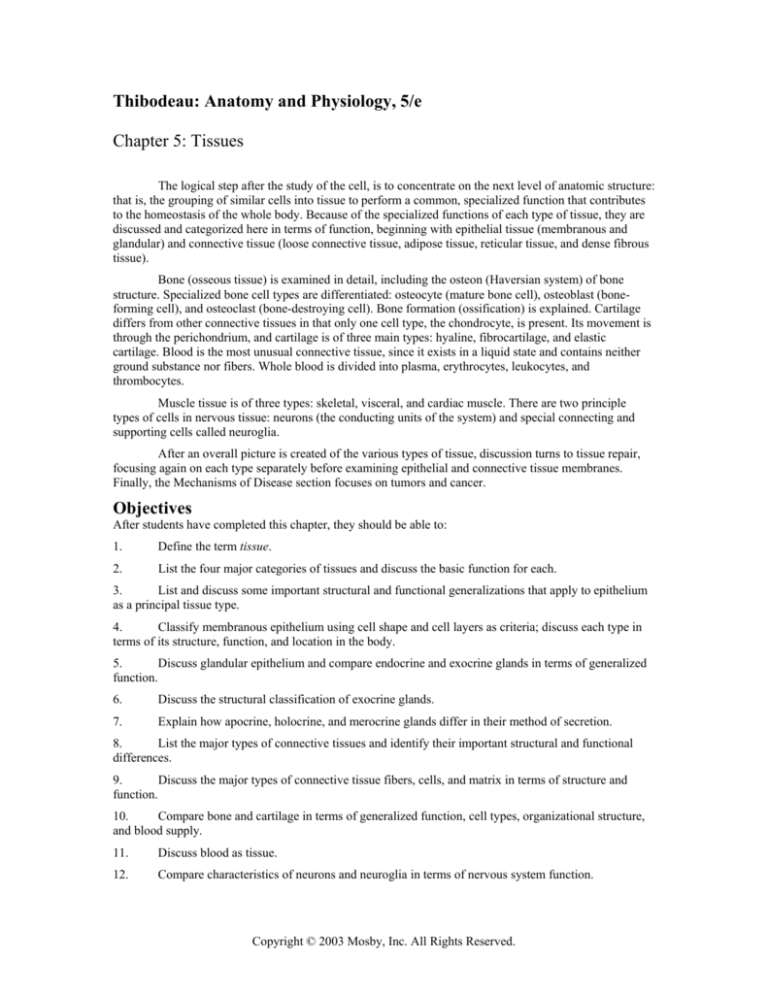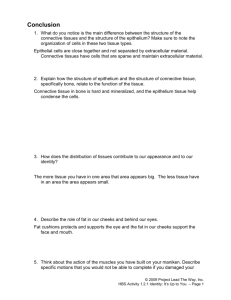
Thibodeau: Anatomy and Physiology, 5/e
Chapter 5: Tissues
The logical step after the study of the cell, is to concentrate on the next level of anatomic structure:
that is, the grouping of similar cells into tissue to perform a common, specialized function that contributes
to the homeostasis of the whole body. Because of the specialized functions of each type of tissue, they are
discussed and categorized here in terms of function, beginning with epithelial tissue (membranous and
glandular) and connective tissue (loose connective tissue, adipose tissue, reticular tissue, and dense fibrous
tissue).
Bone (osseous tissue) is examined in detail, including the osteon (Haversian system) of bone
structure. Specialized bone cell types are differentiated: osteocyte (mature bone cell), osteoblast (boneforming cell), and osteoclast (bone-destroying cell). Bone formation (ossification) is explained. Cartilage
differs from other connective tissues in that only one cell type, the chondrocyte, is present. Its movement is
through the perichondrium, and cartilage is of three main types: hyaline, fibrocartilage, and elastic
cartilage. Blood is the most unusual connective tissue, since it exists in a liquid state and contains neither
ground substance nor fibers. Whole blood is divided into plasma, erythrocytes, leukocytes, and
thrombocytes.
Muscle tissue is of three types: skeletal, visceral, and cardiac muscle. There are two principle
types of cells in nervous tissue: neurons (the conducting units of the system) and special connecting and
supporting cells called neuroglia.
After an overall picture is created of the various types of tissue, discussion turns to tissue repair,
focusing again on each type separately before examining epithelial and connective tissue membranes.
Finally, the Mechanisms of Disease section focuses on tumors and cancer.
Objectives
After students have completed this chapter, they should be able to:
1.
Define the term tissue.
2.
List the four major categories of tissues and discuss the basic function for each.
3.
List and discuss some important structural and functional generalizations that apply to epithelium
as a principal tissue type.
4.
Classify membranous epithelium using cell shape and cell layers as criteria; discuss each type in
terms of its structure, function, and location in the body.
5.
Discuss glandular epithelium and compare endocrine and exocrine glands in terms of generalized
function.
6.
Discuss the structural classification of exocrine glands.
7.
Explain how apocrine, holocrine, and merocrine glands differ in their method of secretion.
8.
List the major types of connective tissues and identify their important structural and functional
differences.
9.
Discuss the major types of connective tissue fibers, cells, and matrix in terms of structure and
function.
10.
Compare bone and cartilage in terms of generalized function, cell types, organizational structure,
and blood supply.
11.
Discuss blood as tissue.
12.
Compare characteristics of neurons and neuroglia in terms of nervous system function.
Copyright © 2003 Mosby, Inc. All Rights Reserved.
Chapter 5: Tissues
2
13.
Explain the process of regeneration as it relates to tissue repair.
14.
Discuss and give examples of the two major types of body membranes.
Lecture Outline
I.
Introduction (p. 123)
II.
Principal Types of Tissue (p. 124)
III.
A.
Epithelial tissue
B.
Connective tissue
C.
Muscle tissue
D.
Nervous tissue
Embryonic Development of Tissues (p. 124)
A.
IV.
Endoderm
2.
Mesoderm
3.
Ectoderm
Gastrulation
C.
Histogenesis
Epithelial Tissue (p. 124; Table 5-3)
B.
VI.
1.
B.
A.
V.
Primary germ layers (Fig. 5-1)
Types and locations
1.
Membranous epithelium
2.
Glandular epithelium
Functions
1.
Protection
2.
Sensory functions
3.
Secretion
4.
Absorption
5.
Excretion
Generalizations about Epithelial Tissue (p. 124)
A.
Limited intercellular space
B.
Basement membrane attached to membranous epithelium (Fig. 5-2)
C.
Avascular
D.
Cells joined by desmosomes and tight junctions
Classification of Epithelial Tissue (p. 125)
A.
Membranous epithelium
1.
Classification based on cell shape (Fig. 5-2)
a.
Squamous
b.
Cuboidal
c.
Columnar
Copyright © 2003 Mosby, Inc. All Rights Reserved.
Chapter 5: Tissues
3
d.
2.
3.
Pseudostratified columnar
Classification based on layers of cells (Fig. 5-2)
a.
Simple
b.
Stratified
c.
Transitional
Classification is complete when based on cell shape and layers (Table
5-1)
B.
a.
Simple squamous epithelium (Figs. 5-3, 5-4)
b.
Simple cuboidal epithelium (Fig. 5-5)
c.
Simple columnar epithelium (Fig. 5-6)
d.
Pseudostratified columnar epithelium (Fig. 5-7)
e.
Stratified squamous (keratinized) epithelium (Fig. 5-8)
f.
Stratified squamous (nonkeratinized) epithelium (Fig. 5-9)
g.
Stratified cuboidal epithelium
h.
Stratified columnar epithelium
i.
Stratified transitional epithelium (Fig. 5-10)
Glandular epithelium (p. 131)
1.
2.
3.
Type of gland by cell number
a.
Unicellular glands
b.
Multicellular glands
Type of gland by discharge location
a.
Exocrine glands
b.
Endocrine glands
Structural classification of exocrine glands (Table 5-2)
a.
b.
4.
VII.
Shape of gland
1)
Tubular
2)
Alveolar
Complexity of the duct
1)
Simple
2)
Compound
Functional classification of exocrine glands (Fig. 5-12)
a.
Apocrine
b.
Holocrine
c.
Merocrine
Connective Tissue (p. 132)
A.
Functions of connective tissue
B.
Characteristics of connective tissue
Copyright © 2003 Mosby, Inc. All Rights Reserved.
Chapter 5: Tissues
C.
4
1.
Matrix
2.
Ground substance
Classification of connective tissue (Table 5-3)
1.
b.
Adipose
c.
Reticular
d.
Dense
Bone
3.
Cartilage
a.
Hyaline
b.
Fibrocartilage
c.
Elastic
Blood
Fibrous connective tissue (p. 135)
1.
Loose connective tissue (areolar) (Fig. 5-13)
2.
Adipose tissue (Figs. 5-14, 5-15)
3.
Reticular tissue (Fig. 5-16)
4.
Dense fibrous tissue (Figs. 5-17, 5-18, 5-19)
Bone tissue (Fig. 5-20; Chapter 7)
F.
Cartilage (p. 140)
1.
Hyaline cartilage (Fig. 5-21)
2.
Fibrocartilage (Fig. 5-22)
3.
Elastic cartilage (Fig. 5-23)
Blood (Fig. 5-24; Chapter 17)
Muscle Tissue (p. 145)
A.
B.
IX.
Loose, ordinary (areolar)
E.
G.
VIII.
a.
2.
4.
D.
Fibrous
Types
1.
Skeletal muscle tissue (Fig. 5-25)
2.
Smooth muscle tissue (Figs. 5-26, 5-27)
3.
Cardiac muscle tissue (Fig. 5-28)
Microscopic anatomy (Chapter 11)
Nervous Tissue (Fig. 5-29; Chapters 12, 13, 14)
A.
Functions
B.
Special characteristics
C.
Nervous system organs
D.
Cell types
1.
Neurons
Copyright © 2003 Mosby, Inc. All Rights Reserved.
Chapter 5: Tissues
5
2.
X.
XI.
Neuroglia
Tissue Repair (p. 147)
A.
Epithelial and connective tissue (Figs. 5-30, 5-31)
B.
Muscle tissue
C.
Nerve tissue
Body Membranes (Fig. 5-32)
A.
B.
Epithelial membranes (Fig. 5-32)
1.
Cutaneous membranes (Chapter 6)
2.
Serous membranes
3.
Mucous membranes
Connective tissue membranes (Fig. 5-32)
1.
Synovial membranes (Chapter 9; Fig. 9-3)
XII.
The Big Picture: Tissues, Membranes and the Whole Body (p. 149)
XIII.
Inflammation (Box 5-3)
A.
XIV.
Inflammation response
Mechanisms of Disease: Tumors and Cancer (p. 149)
A.
B.
C.
Neoplasms (tumors) (Fig. 5-33)
1.
Benign tumors
2.
Malignant tumors (cancers)
Causes of cancer (malignant tumors)
1.
Genetic factors
2.
Carcinogens
3.
Age
Detection and treatment of cancer
1.
2.
Detection
a.
Self-examination
b.
Medical imaging
c.
Blood tests
d.
Biopsy
Treatment
a.
Chemotherapy
b.
Radiation therapy
c.
Laser therapy
d.
Immunotherapy
Copyright © 2003 Mosby, Inc. All Rights Reserved.







